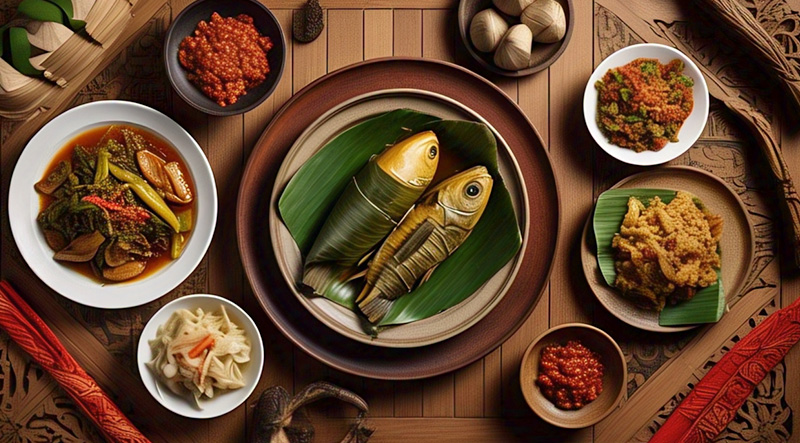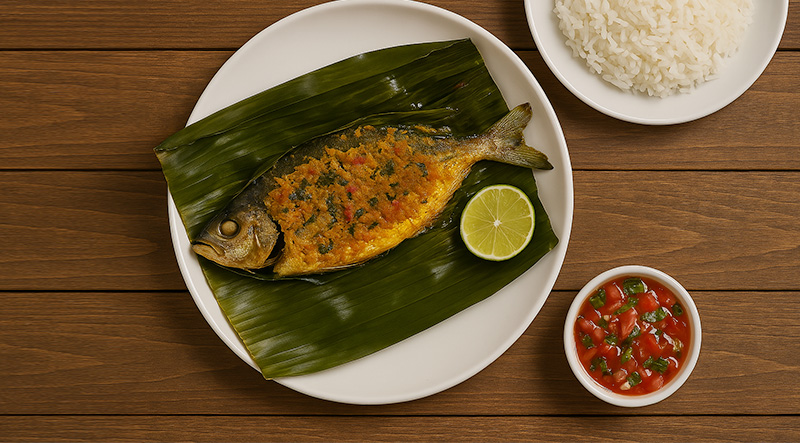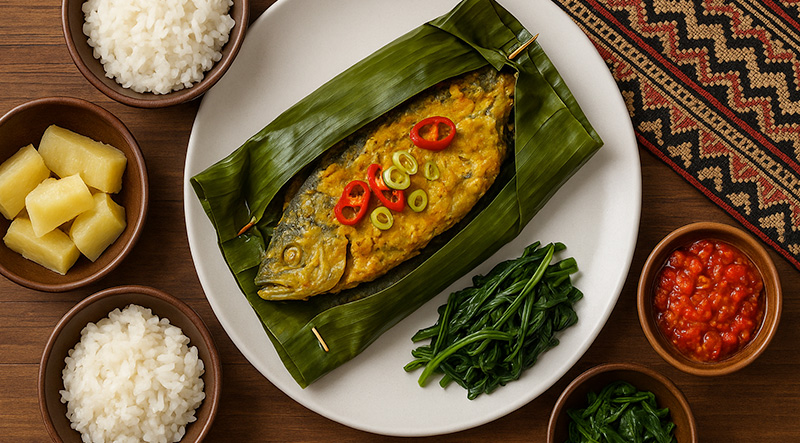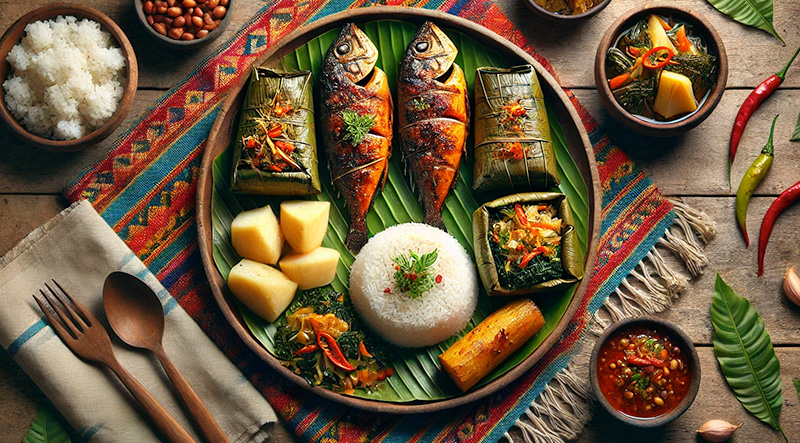Unwrap the bold flavors of East Timor with Ikan Pepes, the island’s beloved national dish that brings the sea and spice together in perfect harmony. This mouthwatering creation features whole fish marinated in a zesty blend of turmeric, garlic, lime, and chilies, then wrapped in fragrant banana leaves and steamed or grilled to tender perfection. With every bite, Ikan Pepes delivers a burst of tropical heat and earthy aroma, capturing the coastal soul and culinary heart of Timor-Leste in one beautifully bundled package. Read More...
Ikan Pepes – The Flavorful Flag-Bearer of East Timor’s Culinary Heritage:
In the young Southeast Asian nation of East Timor (Timor-Leste), Ikan Pepes stands out as a beloved symbol of cultural identity and culinary tradition. This vibrant dish—steamed or grilled fish wrapped in banana leaves with a bold spice paste—captures the essence of Timorese cuisine: simple ingredients, fresh produce, and deep, layered flavor rooted in centuries of heritage. While it shares characteristics with similar dishes from nearby Indonesia, Ikan Pepes in East Timor reflects a uniquely Timorese story shaped by geography, colonial history, and indigenous ingenuity.
Roots in Maritime Tradition:
As a coastal nation surrounded by the bountiful waters of the Timor Sea and Wetar Strait, fish has always been central to the Timorese diet. Generations of local fishermen have relied on daily catches of mackerel, snapper, and sardines to feed their communities. To preserve and enhance the flavor of this fresh seafood, locals developed methods of marinating the fish with aromatic herbs and spices, then wrapping it in banana leaves before cooking over a fire or steaming.
The method of cooking fish in banana leaves is both practical and flavorful. The leaves keep the fish moist, lock in heat, and infuse it with an earthy aroma while allowing the spices to penetrate deeply. This technique, though also found in neighboring Indonesia, Malaysia, and the Pacific Islands, has taken on its own Timorese personality through local variations in spice blends and preferred fish types.
A Colonial Influence with a Local Soul:
During centuries of Portuguese colonial rule, East Timor’s culinary landscape was influenced by European ingredients and techniques. However, the core of Ikan Pepes remained distinctly indigenous. The Portuguese did introduce new crops such as chili peppers and tomatoes, which were quickly adopted into local cooking. These elements complemented traditional Southeast Asian aromatics like turmeric, garlic, shallots, and lemongrass—all of which are now key ingredients in the spice paste that gives Ikan Pepes its fiery, fragrant flavor.
Despite colonial disruption, Timorese families continued to pass down the preparation of Ikan Pepes through generations, often reserving it for special occasions or Sunday meals when families would gather around a communal table.
More Than Just a Dish:
In many parts of East Timor, preparing Ikan Pepes is a shared experience that connects people to the land and sea. Wrapping the fish in banana leaves is a communal task, often done while sharing stories, and the dish is typically accompanied by locally grown rice, boiled cassava, sautéed greens, and a fiery sambal (chili paste). It is food that nourishes the body while honoring tradition and community.
During East Timor’s struggle for independence in the late 20th century, preserving cultural customs—including traditional foods like Ikan Pepes—became an act of quiet resistance and identity. After gaining independence in 2002, the people of Timor-Leste began openly celebrating their heritage, and Ikan Pepes emerged as a symbol of resilience, unity, and national pride.
Ikan Pepes Today:
Today, Ikan Pepes is widely enjoyed across East Timor, from family kitchens in the countryside to beachside grills in Dili. While modern versions may include tweaks or added ingredients, the heart of the dish remains unchanged: fresh fish, bold spices, and banana leaves as nature’s wrapping paper.
It’s commonly served during festivals, holidays, and communal feasts, showcasing the best of what the land and sea have to offer. And for Timorese communities abroad, preparing Ikan Pepes is a way to stay connected to their homeland and pass on a flavorful tradition to the next generation.
A Taste of Timor-Leste:
Ikan Pepes isn’t just a meal—it’s a sensory celebration of East Timor’s identity. With every bite of its tender, spice-infused fish and smoky banana leaf aroma, you taste the rugged coastline, the warmth of village kitchens, and the enduring spirit of a people who’ve turned simplicity into something unforgettable. As East Timor continues to carve out its voice on the global stage, Ikan Pepes remains a proud, delicious symbol of where it’s been—and where it’s going.
Soften the Banana Leaves:
Make the Spice Paste:
Prepare & Season the Fish:

Wrap the Fish:

Cook (Two Easy Options):

Serve:

Cook’s Notes:
Unwrapping each steamy parcel reveals tender fish infused with citrusy, earthy heat—the very taste of coastal Timor-Leste captured in a bundle of green.
The total preparation and cooking time for Ikan Pepes is approximately 1 hour. Preparing the banana leaves, cleaning and seasoning the fish, and blending the spice paste takes about 25–30 minutes. Wrapping the fish securely in the banana leaves and assembling the parcels adds another 10 minutes. Cooking time depends on the method: steaming typically takes 18–20 minutes, while grilling may take around 15 minutes total (or slightly longer if you're using larger fish). With efficient kitchen flow, the entire process—from prepping to plating—can be completed in about an hour, making it a flavorful yet manageable traditional dish to prepare.
A single serving of Ikan Pepes, based on the recipe provided, contains approximately 300 to 400 calories. The whole fish (about 250–300 g raw weight) contributes the bulk of the calories, averaging around 200–250 depending on the type and fat content. The aromatic spice paste, made from shallots, garlic, turmeric, lemongrass, and oil, adds roughly 80–100 calories. If served with a small portion of steamed rice or boiled cassava, that adds another 100–150 calories, though these are optional. Overall, Ikan Pepes is a nutritious, protein-rich dish that remains relatively low in calories while delivering bold flavors and healthy fats.







